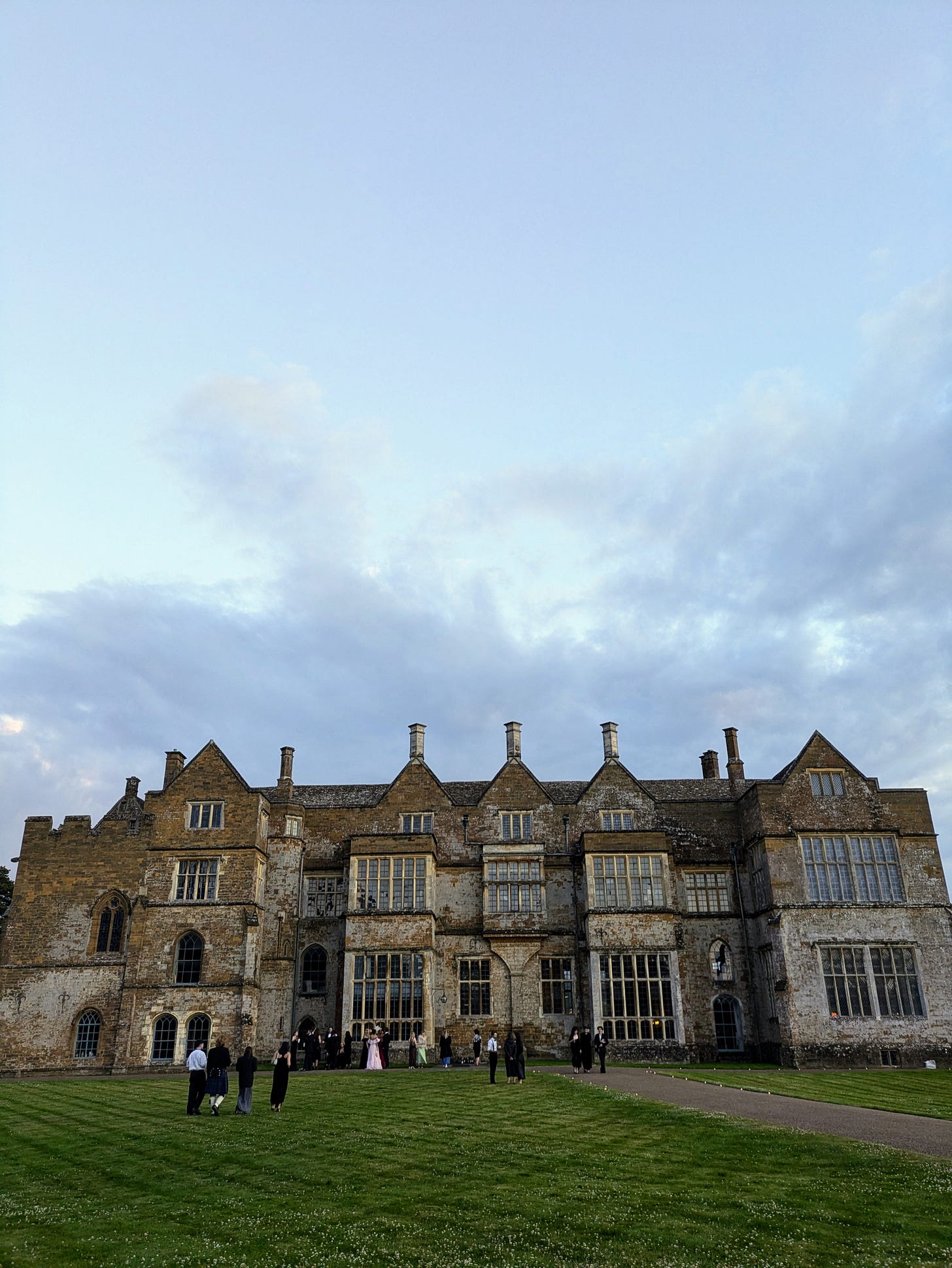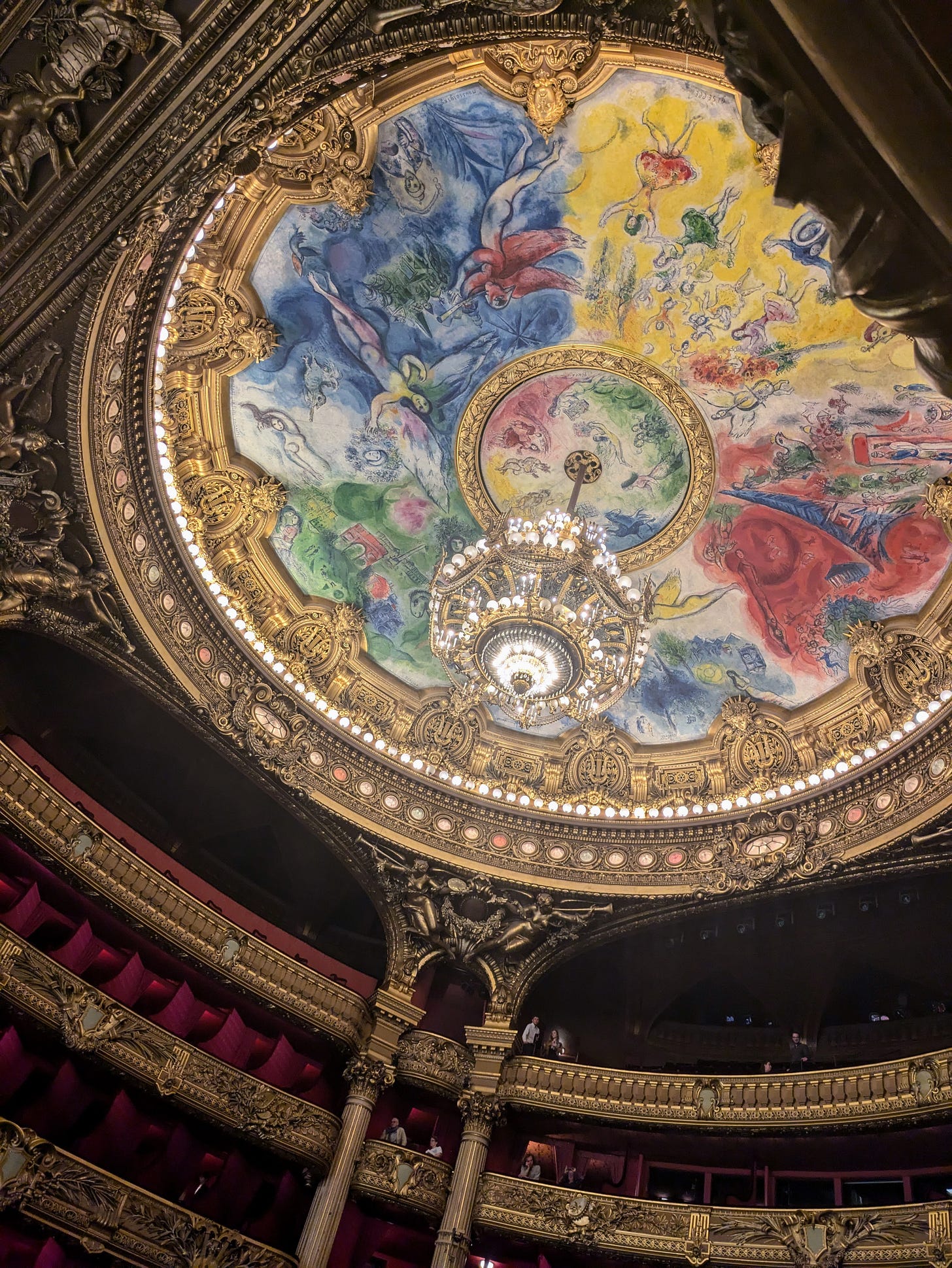Salon friends, Oxford exceeded my expectations this week. Feedback on my year one project was very encouraging, and I’m looking forward to a rich summer of writing.
At the end of our residency, one of our very talented peers organized a creative writing ball to celebrate our first year together, and I got to sing Susanna’s aria for my cohort in a château.
Life can be surreal, especially when you remember your teenage years dreaming in a dusty classroom of rural Pennsylvania.
Back in Paris, I went to see Così fan tutte at the Opéra Garnier. It was the first time I ever had a box seat and being that close to the singers was incredible. It was also fascinating to look out at the sea of audience members in the gilded, history-laden hall.
This week, I thought I’d discuss the ceiling of the Palais Garnier painted by Marc Chagall (1964), a quintessentially Parisian creation.
The ceiling of the Palais Garnier was originally painted by Jules-Eugene Lenepveau in 1871. Chagall’s work is suspended on top of Lenepveau’s more traditional work, a beautiful example of how Paris preserves the past while welcoming the future.
In 1960, writer André Malraux, France’s first minister of cultural affairs, approached Chagall about producing the painting. Chagall was initially hesitant, as were the opera’s more conservative patrons who were appalled not only by the idea of a modernist painter but a foreign one. In the end, Chagall accepted the task, and his magic won the hearts of Paris.
Chagall’s painting is organized in five different colors, each panel associated with different composers and their works. In blue, Chagall included Moussorgski’s Boris Godounov and Mozart’s The Enchanted Flute; in green Wagner’s Tristan and Isolde and Berlioz’s Roméo et Juliette; in white Debussy’s Pelléas et Mélisande and Rameau with the Palais Garnier; in red Ravel’s Daphnis et Chloé and Stravinsky’s The Firebird; in yellow Tchaikovsky’s Swan Lake and Adam’s Giselle.
The smaller inner circle holds Bizet’s Carmen in red, Verdi’s La Traviata in yellow, Beethoven’s Fidelio in green, and Gluck’s Orpheus and Eurydice in blue.
Amongst all these lyrical references, Chagall painted Parisian monuments like the Eiffel Tower and the Arc de Triomphe sprinkled amongst musical instruments and winged figures.
While researching the painting’s history, I found this beautiful quote:
Il faut faire chanter le dessin par la couleur.
One must make drawing sing through color.
-Marc Chagall
As a writer and singer, I love the cross-genre implications of these words, how different forms can inform our work. Using vocabulary from different mediums can sometimes help me get a fresh perspective on pieces I’m struggling with, or lead to entirely new ideas.
When I look up at Chagall’s painting in the Palais Garnier, I see fresh color and movement framed in the gold elegance of the past. For me, the work embodies the ideal position of the contemporary artist, one who respects and is inspired by predecessors all the while offering something entirely new. These two things can exist simultaneously; in fact, I think each is richer when both are present.
I’ll end with Chagall’s own words on his creation, stated at the unveiling of the work:
Up there in my painting I wanted to reflect, like a mirror in a bouquet, the dreams and creations of the singers and musicians, to recall the movement of the colorfully attired audience below, and to honor the great opera and ballet composers... Now I offer this work as a gift of gratitude to France and her École de Paris, without which there would be no color and no freedom.
I love thinking about the opera ceiling as a dream collector, like a giant thought bubble above the artists and the audience. I also find it wonderful that Chagall thought about all the different people involved in the opera, not just the composers. The opera is made of singers, musicians, dancers, audience members, and various workers, each one playing an important role in the whole experience.
As I like to emphasize here at Salon Nouveau, Paris is an incredible place to be an artist. Like Chagall, I want to thank France for all she has given me: beauty, reflection, time, conversation. I’m feeling deeply grateful for my life this week. It hasn’t always been easy, but with hard work and dedication, one can cultivate one’s voice in Paris.
Salon friends, what do you think about the juxtaposition of Chagall’s modern work with the Napoleon III style of the Palais Garnier? Inspiring or wrong? A dream or too much?
Have a great week, et à la prochaine !
Rachel









I personally like it a lot. There was a fascinating exhibit on Chagall and music a few years ago, did you get to see it?
Personally, I love the juxtaposition. Fond memories of meeting friends on the steps of the Opéra when I lived & worked in Paris as a teaching 'assistante' a number of years ago - how I wish I'd had the courage (& cash) to go in! Definitely planning a visit next time I'm there.